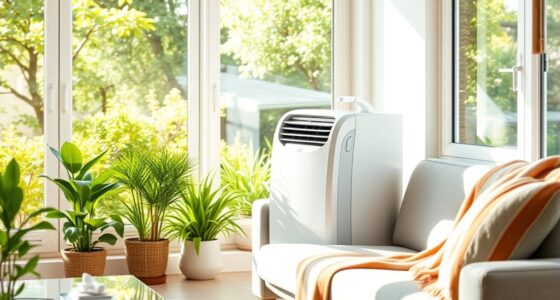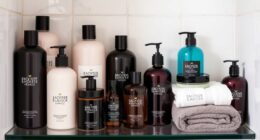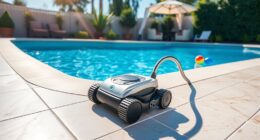A dehumidifier helps control indoor humidity by pulling moist air over refrigerated coils or absorbent materials, condensing water to lower moisture levels. Choosing the right type—mechanical or desiccant—depends on your space and climate. Maintaining a humidity level between 30% and 50% prevents mold growth and reduces musty odors. Proper placement, regular maintenance, and complementary moisture control strategies make dehumidifiers most effective. To learn more about maximizing your dehumidifier’s benefits, keep exploring the key details.
Key Takeaways
- Properly select between mechanical and desiccant dehumidifiers based on your environment’s temperature and humidity levels.
- Maintain optimal indoor humidity levels between 30% and 50% to prevent mold growth and condensation.
- Place dehumidifiers in high-moisture areas, ensuring adequate airflow and regular maintenance for maximum efficiency.
- Use a hygrometer to monitor humidity and adjust dehumidifier operation seasonally to control excess moisture.
- Combine dehumidifier use with environmental controls like ventilation, sealing leaks, and moisture barriers for comprehensive mold prevention.
How Dehumidifiers Work to Reduce Indoor Moisture

Dehumidifiers work by pulling in moist indoor air and passing it over refrigerated coils or desiccants that condense the excess moisture into water. As the air circulates through the device, the moisture condenses and is collected in a reservoir or drained away automatically, effectively reducing humidity levels. The dehumidifier then releases the drier, reheated air back into the room, helping to control indoor moisture. This process continuously lowers humidity, preventing mold growth and improving indoor air quality. By removing excess moisture, dehumidifiers help maintain ideal moisture levels, which are essential for healthy indoor air and moisture control. Regular operation promotes air quality and creates a healthier living environment, especially in areas prone to dampness. Additionally, some models incorporate smart technology for automatic operation based on humidity levels, enhancing ease of use and efficiency. Proper maintenance of dehumidifiers is crucial to ensure optimal performance and longevity, preventing issues like mold and bacteria buildup.
The Types of Dehumidifiers and Their Features

Different dehumidifiers suit various needs, with mechanical and desiccant models offering distinct advantages. Mechanical units are great for most indoor spaces, while desiccant types excel in colder environments. Understanding their features, maintenance needs, and performance helps you choose the right option for your space. Additionally, considering personal development techniques like goal setting and mindfulness can help you make more informed decisions regarding your home environment. For example, choosing the appropriate dehumidifier can significantly impact your indoor air quality, which in turn affects overall health and comfort. Recognizing the performance differences between models can further assist in selecting a device that matches your specific humidity control requirements. Moreover, staying informed about AI security vulnerabilities can help you select safer, more reliable appliances and systems for your home. It is also beneficial to review credit card security measures to ensure your payment data remains protected when purchasing these devices online.
Mechanical vs. Desiccant Types
When choosing between mechanical and desiccant dehumidifiers, understanding their distinct features can help you select the right one for your space. Mechanical dehumidifiers use refrigeration coils to condense moisture, making them ideal for warmer environments with moderate humidity. They provide effective indoor humidity control and are suitable for mold prevention in conditioned spaces, but tend to produce more noise and consume more energy. Desiccant dehumidifiers rely on absorbent materials like silica gel to remove moisture, excelling in low-temperature operation and unconditioned spaces such as basements or crawl spaces. They are quieter and more energy-efficient, especially at temperatures as low as 33°F. Your choice depends on environmental conditions, with mechanical units favored for warmer areas and desiccants for colder or unconditioned environments. Proper moisture removal techniques are also crucial for preventing mold growth and maintaining healthy indoor air quality. Additionally, energy efficiency can vary significantly between types, impacting long-term operating costs. Incorporating humidity control strategies is vital for optimal performance and health benefits. Proper ventilation is also essential for maintaining balanced indoor humidity levels and preventing mold. Understanding the environmental considerations associated with each type can help ensure effective and sustainable dehumidification.
Maintenance and Performance
Maintaining your dehumidifier’s performance requires regular care and attention to its features. Start with filter cleaning to prevent dust buildup, which can hinder airflow and reduce efficiency. Water tank maintenance is essential to avoid mold growth and ensure smooth drainage. Coil inspection keeps refrigeration or desiccant components dust-free, optimizing performance. Features like automatic shut-off and humidity sensor calibration help maintain consistent humidity levels while preventing overuse. Regular upkeep with these tasks maximizes energy efficiency and extends your dehumidifier’s lifespan. Proper maintenance not only ensures mold prevention but also enhances performance optimization. Incorporating industry trends into your maintenance routine can also help you stay informed about new features and improvements. Additionally, keeping an eye on filter replacement schedules ensures your unit continues to operate at peak performance. Regularly checking for cooling system issues can further prevent breakdowns and improve longevity. Whether you have a mechanical, desiccant, or electrical model, consistent care keeps your unit running smoothly, saving energy and providing reliable humidity control for your space. Remember that filter quality can significantly impact the overall efficiency and lifespan of your dehumidifier, making it an important aspect of maintenance.
Ideal Humidity Levels for Mold Prevention
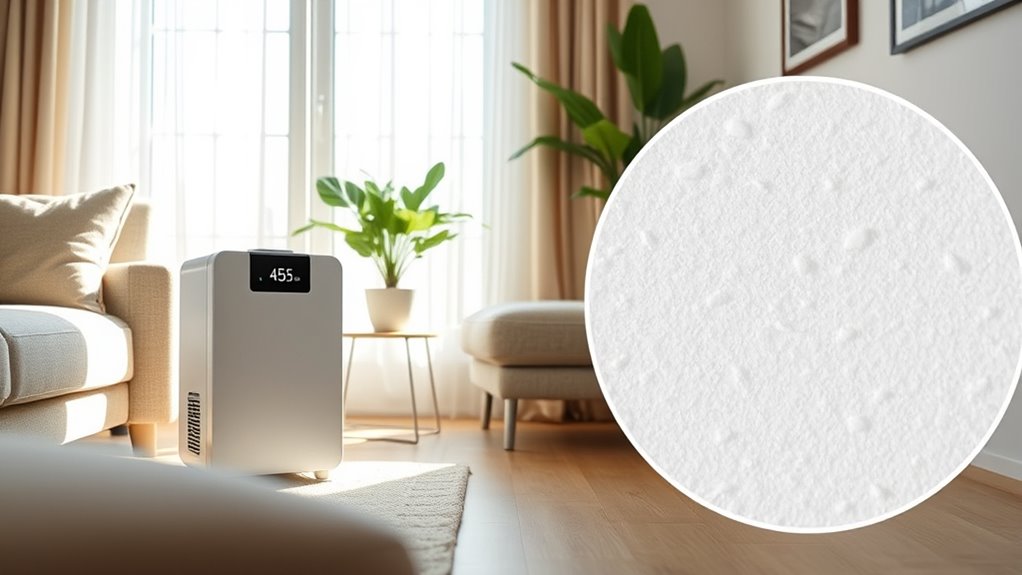
Keeping your indoor humidity between 30% and 50% helps prevent mold growth by reducing excess moisture. If humidity stays above 50%, you might notice signs like condensation or a musty smell. Using a hygrometer guarantees you maintain the ideal range for mold prevention and healthier air.
Optimal Humidity Range
Have you ever wondered what the ideal humidity level is to prevent mold growth? The optimal humidity range for mold prevention is between 30% and 50%. Maintaining this range improves indoor air quality and promotes effective moisture control. To achieve this, consider these key points:
- Use a hygrometer to monitor humidity levels precisely.
- Keep humidity within the recommended range for moisture reduction and mold prevention.
- Adjust your dehumidifier seasonally to prevent humidity from exceeding 50%, especially during humid months.
Staying within this humidity range minimizes mold growth risk and helps preserve your property. Proper moisture management ensures healthier indoor air and reduces potential health problems caused by excess moisture.
Signs of Excess Moisture
When humidity levels rise above the recommended 30% to 50%, signs of excess moisture quickly become noticeable in your home. You might see visible mold or mildew on walls, ceilings, or surfaces, especially in high-humidity areas like basements and bathrooms. Persistent musty odors often indicate elevated humidity conducive to mold growth. Condensation on windows, pipes, or walls is a clear sign that humidity exceeds healthy levels. Additionally, look for peeling paint, bubbling wallpaper, or damp spots, which reveal high moisture levels. These physical signs point to excess moisture that can lead to mold and mildew development. Addressing these indicators promptly helps prevent long-term damage and maintains a healthier indoor environment.
Common Areas Prone to Excess Moisture and Mold Growth

Certain areas in your home are especially vulnerable to excess moisture and mold growth, often due to inadequate ventilation or persistent water exposure. These damp areas can elevate humidity and moisture levels, creating ideal conditions for mold growth. To reduce risks, focus on these key zones:
- Bathrooms – shower steam and water splashes raise humidity, promoting mold if not ventilated.
- Basements – ground seepage and poor drainage increase moisture, leading to mold development.
- Kitchens and laundry rooms – cooking, dishwashing, and damp laundry contribute to high humidity and persistent dampness.
Using a dehumidifier helps control humidity, improve indoor air quality, and prevent mold. Managing excess moisture in these areas is essential for maintaining a healthy indoor environment and mold prevention.
Proper Placement and Usage of Dehumidifiers
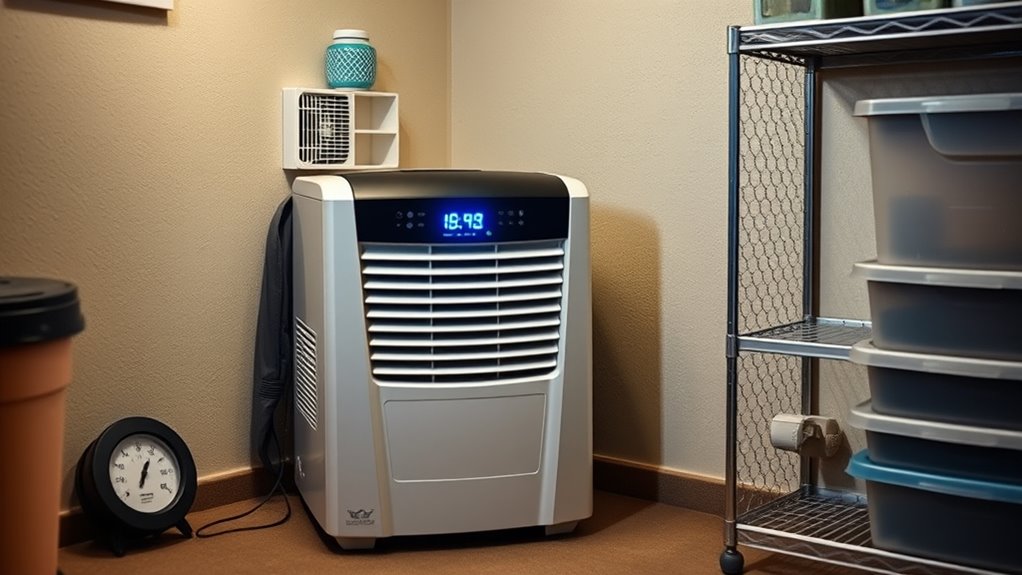
To maximize the effectiveness of your dehumidifier, it’s important to place it correctly within the room. Position it in an ideal location, such as the center of the area with the highest humidity levels, to improve airflow and moisture removal. Ensure there’s at least 6-12 inches of clearance on all sides to promote proper air circulation and prevent airflow restrictions. Keep the unit away from walls, furniture, or curtains, which can hinder moisture control. Place it on a level, waterproof surface to avoid vibrations and water damage. Regularly monitor humidity levels and adjust the placement if needed to maintain ideal moisture levels between 30-50%. Proper positioning and clearance are essential for effective moisture removal and mold prevention.
Regular Maintenance and Troubleshooting Tips
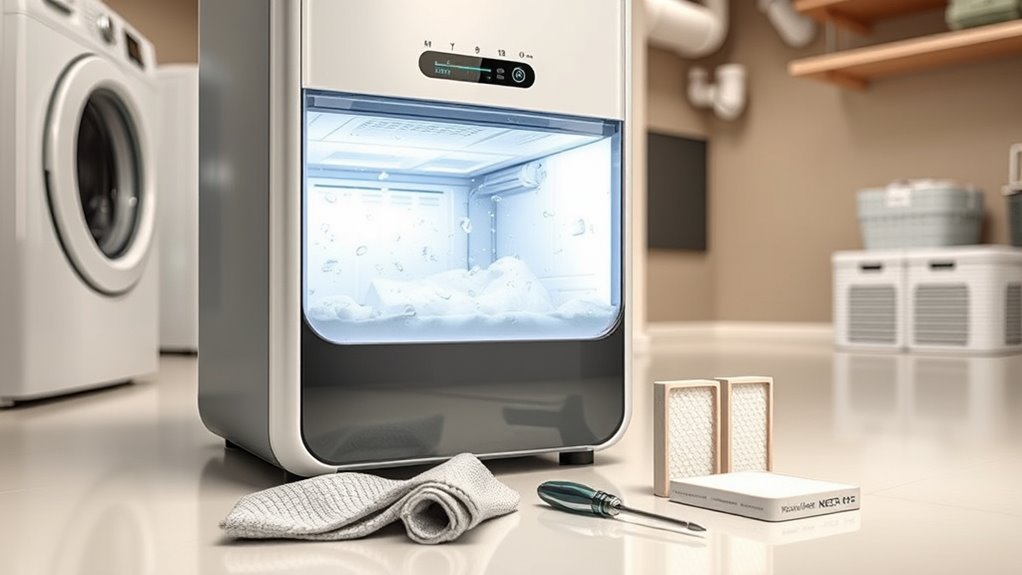
Maintaining your dehumidifier regularly guarantees it operates efficiently and prevents costly repairs. Proper dehumidifier maintenance involves key tasks:
Regular dehumidifier maintenance ensures efficiency and prevents costly repairs.
- Clean or replace the filter every 1 to 3 months to ensure ideal airflow and efficiency.
- Empty the water reservoir frequently or connect a drain hose for continuous operation, preventing overflow and water damage.
- Disinfect the interior and water collection tank weekly with vinegar to prevent mold and bacteria buildup.
Additionally, check for coil frost or ice, which signals a malfunction or low ambient temperature. An annual inspection by a professional helps catch issues early, ensuring all components function correctly. Regular maintenance keeps your dehumidifier running smoothly, prolongs its lifespan, and safeguards your home from mold and humidity problems.
Complementary Strategies for Mold Prevention

Implementing complementary strategies alongside your dehumidifier substantially enhances mold prevention efforts. Proper ventilation, like exhaust fans and good air circulation, helps maintain low humidity levels, making it harder for mold to thrive. Sealing leaks and cracks, along with using moisture barriers, prevents external humidity from entering your space. Addressing leaks and condensation sources directly reduces excess moisture, supporting humidity control. Environmental controls such as insulation and proper drainage sustain low humidity levels and stabilize indoor conditions. Regular maintenance of your dehumidifier ensures it operates efficiently, boosting mold prevention. By combining these approaches, you create a thorough moisture management system that reduces mold risk and maintains a healthier environment. These strategies work together to keep humidity low and moisture unseen.
Myths and Misconceptions About Dehumidifiers

Many believe dehumidifiers kill mold, but they only lower moisture levels; you still need to remove existing mold physically. The size of your dehumidifier matters—if it’s too small, it won’t do the job effectively. Understanding these myths helps you use your dehumidifier correctly for better mold prevention.
Dehumidifiers Kill Mold
While dehumidifiers are effective at controlling moisture levels, they don’t actually kill mold spores. Their role is to prevent mold growth by maintaining indoor humidity between 30-50%, which inhibits mold proliferation. Keep in mind:
- Dehumidifiers help mold prevention but don’t eliminate existing mold, which requires physical removal.
- Mold spores can survive dry conditions if organic materials are present, so moisture control alone isn’t enough for mold removal.
- Improving indoor air quality involves addressing moisture sources and maintaining *ideal* humidity, not relying solely on dehumidifiers.
Size Determines Effectiveness
Choosing the right-sized dehumidifier is essential for effective moisture control. Your room size determines the capacity needed to maintain ideal humidity levels and guarantee proper sizing. An undersized unit won’t remove enough moisture, leaving humidity high and risking mold growth. Conversely, an oversized dehumidifier may cycle frequently, reducing performance and increasing energy costs, without better moisture removal. Many misconceptions suggest larger units work faster, but proper space coverage and capacity matter most for moisture management. To achieve effective control, calculate your room’s square footage, consider existing moisture sources, and select a dehumidifier with the appropriate capacity. Proper sizing improves air quality, enhances performance, and guarantees your dehumidifier effectively manages humidity levels for a healthier space.
Monitoring Indoor Humidity: Tools and Techniques
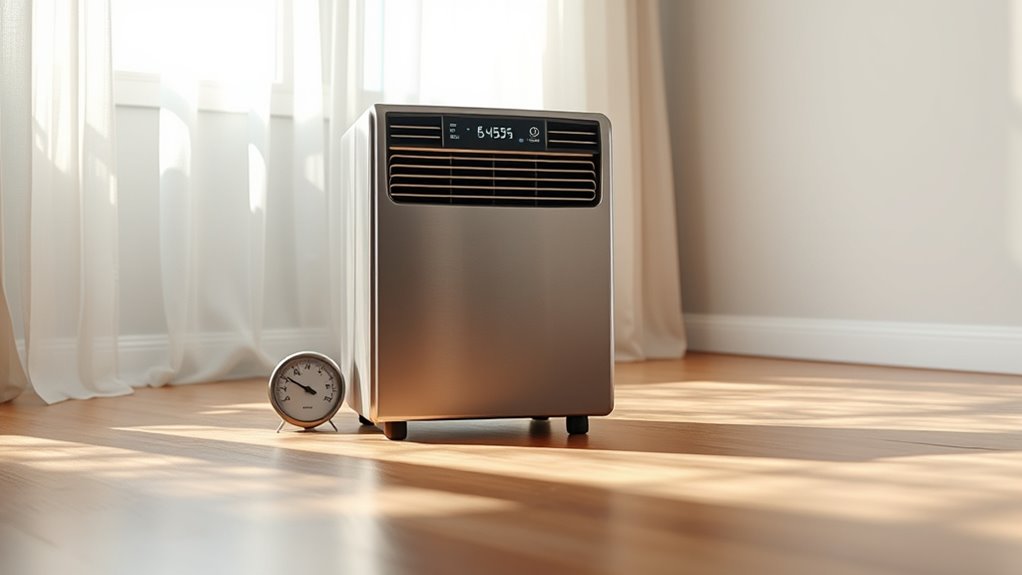
Monitoring indoor humidity effectively requires the right tools and techniques to guarantee a healthy environment. A hygrometer is essential for accurately measuring indoor humidity levels, typically displaying between 0-100%. Digital hygrometers offer added benefits like memory storage, alerts, and connectivity for continuous monitoring. To optimize your setup:
Monitoring indoor humidity with a reliable hygrometer ensures a healthy, mold-free environment.
- Use a reliable hygrometer to monitor humidity consistently.
- Check levels regularly, especially in moisture-prone areas like basements and bathrooms.
- Troubleshoot device alerts promptly to maintain ideal humidity and prevent mold growth.
Long-Term Benefits of Using a Dehumidifier in Your Home
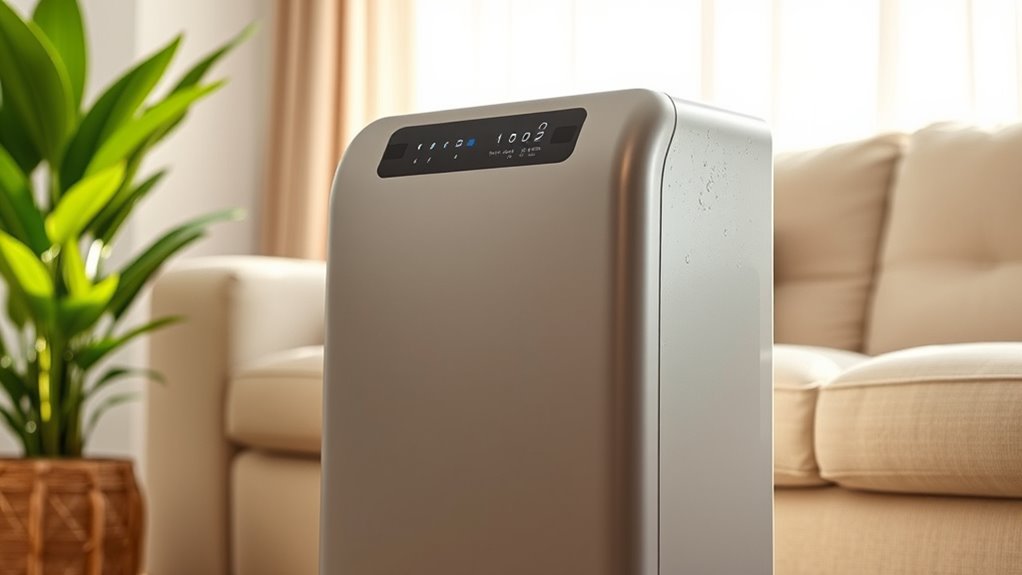
Using a dehumidifier consistently offers long-term benefits that protect your home and health. By maintaining ideal humidity control between 30-50%, you greatly reduce mold prevention risks and prevent moisture levels from damaging your property. A dehumidifier improves indoor air quality by lowering allergens like mold spores and dust mites, making your environment healthier. It also supports home preservation by preventing issues such as warping, peeling, and corrosion caused by excess moisture. Additionally, sustained humidity control enhances energy efficiency, reducing the workload on your heating and cooling systems, which cuts energy costs. The health benefits extend further, alleviating allergy symptoms and respiratory problems associated with damp environments. Overall, using a dehumidifier long-term ensures a cleaner, safer, and more comfortable living space.
Frequently Asked Questions
What Is the Best Dehumidifier Setting to Prevent Mold?
You’re wondering about the best dehumidifier setting to prevent mold. To do this effectively, keep your indoor humidity between 30% and 50%. Setting your dehumidifier around 45% strikes a good balance, making the environment less inviting for mold growth while maintaining comfort. Regularly check your humidity levels with a hygrometer, especially in damp areas like basements and bathrooms, and adjust as needed to stay within this ideal range.
What Is the Best Humidity Level to Prevent Mold?
When it comes to preventing mold, you want to keep your indoor humidity in check—it’s the key to staying ahead of trouble. Experts recommend maintaining relative humidity between 30% and 50%, which is like walking a tightrope. Keeping levels below 60% makes it harder for mold spores to thrive. Use a hygrometer to keep an eye on the numbers and guarantee your home stays in the safe zone.
What Should the Humidifier Setting Be to Prevent Mold?
You’re asking what setting to use on your humidifier to prevent mold. To do this effectively, set your humidifier to maintain indoor humidity levels between 30% and 50%. Aim for around 40%, as it offers a good balance to inhibit mold growth while keeping your space comfortable. Use a hygrometer regularly to monitor the humidity, adjusting your device as needed to stay within this safe range.
Will Mold Grow at 55 Humidity?
Like a cautious gardener tending to delicate plants, you wonder if mold will grow at 55% humidity. While most mold species slow down or halt growth below 60%, some can still develop at 55%. Keeping humidity at or below this level considerably reduces mold risk, but it’s not a guarantee. Fluctuations, temperature, and materials also influence mold growth, so maintaining consistent humidity is your best defense.
Conclusion
Just as Pandora’s box released unforeseen troubles, neglecting proper humidity control can invite mold and health issues into your home. But with a dehumidifier, you hold the key to a safer, healthier space. By understanding how it works and staying vigilant, you can prevent problems before they arise. Take charge now—your home’s comfort and your well-being depend on the steps you choose today. Don’t let moisture’s myth become your reality.




